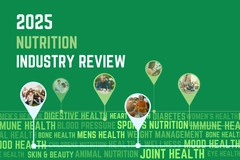
- Industry news
Industry news
- Category news
- Reports
- Key trends
- Multimedia
Multimedia
- Journal
- Events
- Suppliers
Suppliers
- Home
- Industry news
Industry news
- Category news
- Reports
- Key trends
- Multimedia
Multimedia
- Events
- Suppliers
Suppliers
Vitamin-rich sugar kelp poised to make waves in US market

12 Sep 2022 --- Researchers at Uconn extension, College of Agriculture, Health and Natural Resources, are increasing the accessibility of the superfood seaweed. The team is looking to expand the supply and demand for sugar kelp, a seaweed species, by providing research and community outreach.
As it stands, sugar kelp is not widely accessible in Connecticut, US, nor is it highly desired by consumers. The researchers want to change that and demonstrate to farmers and buyers that sugar kelp is a healthy and environmentally sustainable food option.
“The industry is still small and facing some challenges, but we’re going to continue working on getting sugar kelp on the menu in more homes and restaurants,” says Anoushka Concepcion, associate extension educator at the College of Agriculture, Health and Natural Resources.
Increasing accessibility
By using knowledge of the seaweed life cycle, the researchers were able to educate local shellfish farmers in Connecticut on how to diversify their crops and grow the seaweed.
From the crop diversification, the researchers expressed that the producers are “not only growing a versatile, environmentally friendly product, but they are also minimizing their financial risks and improving economic viability.”
 Connecticut researchers are trying to create a rise in demand for sugar kelp. The outreach was conducted to increase the supply of seaweed in Connecticut’s market and make it more accessible for consumers. The accessibility is then expected to drive up desire and increase profit for the farmers.
Connecticut researchers are trying to create a rise in demand for sugar kelp. The outreach was conducted to increase the supply of seaweed in Connecticut’s market and make it more accessible for consumers. The accessibility is then expected to drive up desire and increase profit for the farmers.
The producers partnered with Sea Grant to secure federal grants in 2013 and 2015. The partnership identifies any possible seaweed food safety hazards. The results were the nation’s first publication on seaweed food safety; however, the report is specific to Connecticut seaweeds but can be referenced internationally as a model.
“We’re making sure public health officials and farmers have the information they need about what successful seaweed farming looks like in Connecticut,” states Concepcion.
Sustainable and nutritional benefits
Seaweed is a broad name for many species of marine algae. The species the researchers are focusing on is sugar kelp which is found in shallow coastal areas. It has a long wavy strand shape and a yellow, brown color.
Sugar kelp has many different vitamins and nutrients, which makes it a desirable option for researchers to explore. The kelp contains fiber, vitamins, and minerals like iron, calcium, iodine, magnesium, vitamin C and vitamin K.
NutritionInsights has reported on the skin benefits of a seaweed extract that has the “potential to prevent and improve skin aging, while also offering anti-inflammatory properties.”
Seaweed, a food with a hefty supply of vital nutrients, has also been researched to aid food scarcity and world hunger.
The plant is grown from sunlight and takes up excess nutrients and carbon dioxide from the water it grows in. Sugar kelp also has been shown to provide environmental benefits in the areas it has grown in.
Currently, sugar kelp is used in soups and salads in other parts of the world due to its sweet flavor and thick texture.
Supply versus demand
The extension outreach program provides access to new markets that help farmers extend their season. They hope doing so will help increase consumer demand and product access.
The researchers predict that demand from customers must be shown in order for producers and other food industry members to feel comfortable adding sugar kelp to their food portfolios.
Sugar kelp farmers aren’t producing at their maximum capacity due to farming operations and having to be responsible for their distribution and marketing. Outreach programs are working to bridge the gap between seaweed farming and distributors.
Outreach programs are working to bridge the gap between seaweed farming and distributors.
“While there’s a lot of interest in seaweed farming from producers, we really need to see increased and consistent sales from consumers. Supply and demand don’t match right now,” continues Concepcion.
If consistent sales are shown, that could justify the cost for producers to invest in safe and long-term storage for the kelp. The sales would then expand the access to year-round markets. More farmers could be encouraged to join in from expanding markets if they see it as a profitable venture.
“Consumers are interested, but they’re unable to get their hands on it,” Concepcion says.
A current obstacle is kelps’ short shelf life. The researchers are looking into how to make it last longer as a cause of Connecticut’s short growing season.
There is still much to take on regarding a smooth introduction of sugar kelp. Distributors must be introduced to the industry, another kelp food system barrier.
Extension outreach tries to “inform multiple audiences about the barriers, including preservation and distribution, that exist for the industry.”
Phase two of the project is set to begin in January 2023. Those involved have received renewed funding from the National Oceanic and Atmospheric Administration to create a National Seaweed Hub to expand and improve operations.
Edited by Sabine Waldeck











